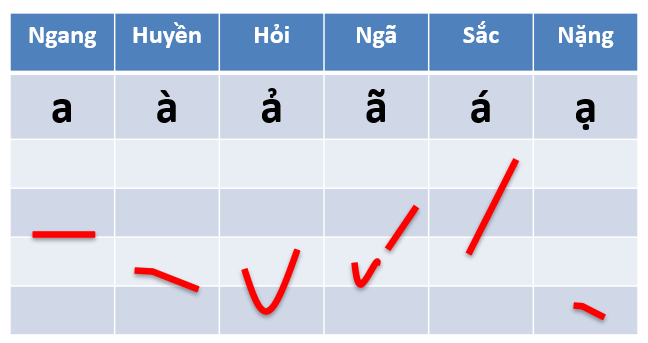Section 2: Tone and Tone marks
1/ General overview:
Vietnamese is a tonal language with 6 tones and 5 tone marks. They are:
-
-
-
- Thanh ngang
- Thanh sắc – Dấu sắc
- Thanh huyền – Dấu huyền
- Thanh hỏi – Dấu hỏi
- Thanh ngã – Dấu ngã
- Thanh nặng – Dấu nặng
The word “Thanh” refers to the tone, while “Dấu” means Marks and refers to how the tone is indicated when writing. This means there is no mark for Thanh ngang.
When writing tone marks in a word, make sure to put them on a vowel, not a consonant:
- If there is only one vowel, the tone mark is put on that vowel
Mã Mình Bạn Cùng - If there are two or three vowels, but no consonant at the end, the tone mark is put on the second to last vowel
Hòa Kiểu Hai Mỗi - If there are two or three vowels, and there is a consonant at the end, the tone mark is put on the last vowel
Tiếng Việt Nguyễn Quỳnh
2/ Pitches and formation:
There are various ways to translate the name of these tones. The table below combines two approaches; one is the literal translation, and the other is based on the pitches when forming the tone:
Literal Translation and Pitches and Formation of Tone Tone Literal translations Pitches and formation Thanh ngang Flat tone Mid-level tone Thanh sắc Sharp tone High rising tone Thanh huyền Grave tone Low falling tone Thanh hỏi Question tone Low rising tone Thanh ngã Stumbling tone Low rising-broken tone Thanh nặng Heavy tone Low dropping tone Listen to this audio file that demonstrates the pitch of the tones.
The diagram below shows the pitch level when forming the tones:

The diagram shows the pitch level when forming the tones source: svff.info
3/ Importance of tones and tone marks:
The use of tones is extremely important, as a different tone may cause the word to have an entirely new meaning. For example:
- Ma = Ghost
- Mà = But
- Má = Mother/Cheek
- Mả = Grave
- Mã = Horse (Chinese origin), Appearance
- Mạ = Young rice stalk, Coating
Or:
- Ba = Three, Father
- Bà = Grandmother, Mrs.
- Bá = Super, Aunt
- Bả = Poison
- Bã = Residue
- Bạ = Indiscriminate
4/ Confusing tone pairs:
a/ Thanh sắc vs. Thanh ngã
- Thanh sắc: The high rising tone:
- To create this tone, imagine you are very surprised and are asking people “WHAT?” with a rising, even screeching tone.
- The air should flow freely in your throat as you gradually raise your voice.
- Examples of Thanh sắc:
Nói, Sáng, Tốt, Tối, Đúng, Phút
- Thanh ngã: The rising-broken tone:
- To create this tone, you must first partially close the pharynx (the throat) to restrict the airflow.
- Then raise your voice the same way with Thanh sắc.
- Due to the restricted airflow, it will sound like you are struggling to speak. In other words, the sound will seem broken, rather than smooth.
- Examples of Thanh ngã:
Chữ, Sẽ, Mỹ, Rưỡi, Bữa, Mỗi
b/ Thanh ngang vs. Thanh huyền
- Thanh ngang: The mid-level tone
- To create this tone, widely open your throat to let the air flow freely.
- Keep your voice at a constant and monotonous level. You can choose to keep it at a middle or high level.
- Do not lower your voice even at the end of a word.
- Examples of Thanh ngang:
Tên, Ngôn, Anh, Trưa, Đêm, Chơi
- Thanh huyền: The low-falling tone:
- This is perhaps the easiest tone to produce for English speakers.
- To create this tone, gradually lower your voice to a middle level, like you often do at the end of a word or a sentence in English.
- The air should be able to flow freely at first, then gradually becomes restricted.
- Examples of Thanh huyền:
Chào, Người, Giờ, Ngành, Bài, Đường
c/ Thanh hỏi vs. Thanh nặng
- Thanh hỏi: The low-rising tone
- In Vietnamese, “Hỏi” means “Question”, which somewhat reflects the nature of this tone, as it sounds like someone is unsure and is reconfirming information.
- To produce this sound, you should open your pharynx (the throat) to allow the air to flow freely.
- Keep your voice at a mid-level at the beginning.
- Block the flow of air through your nose as you gradually lower your tone.
- Only let the air flow out from your mouth! A trick is to pinch your nose when practicing the tone.
- Examples of Thanh hỏi:
Hỏi – Hả – Phải – Nhỉ – Của – Chỉ
- Thanh nặng: The low-dropping tone:
- In Vietnamese, “Nặng” means heavy, which explains why this is the heaviest tone in the language.
- To create this tone, keep your tone as low as possible at the beginning.
- Stop the airflow with your throat, only let a tiny fraction of the air escape from your pharynx.
- In fact, as long as you can stop the airflow, you will produce the Heavy tone, no matter how high you start your voice at.
- Examples of Thanh nặng:
Mạ, Một, Nặng, Mệt, Chị, Mẹ
Let’s have some practice :
LUYỆN TẬP 1:
LUYỆN TẬP 2:
LUYỆN TẬP 1:
-
-
Media Attributions
- Pitch chart

